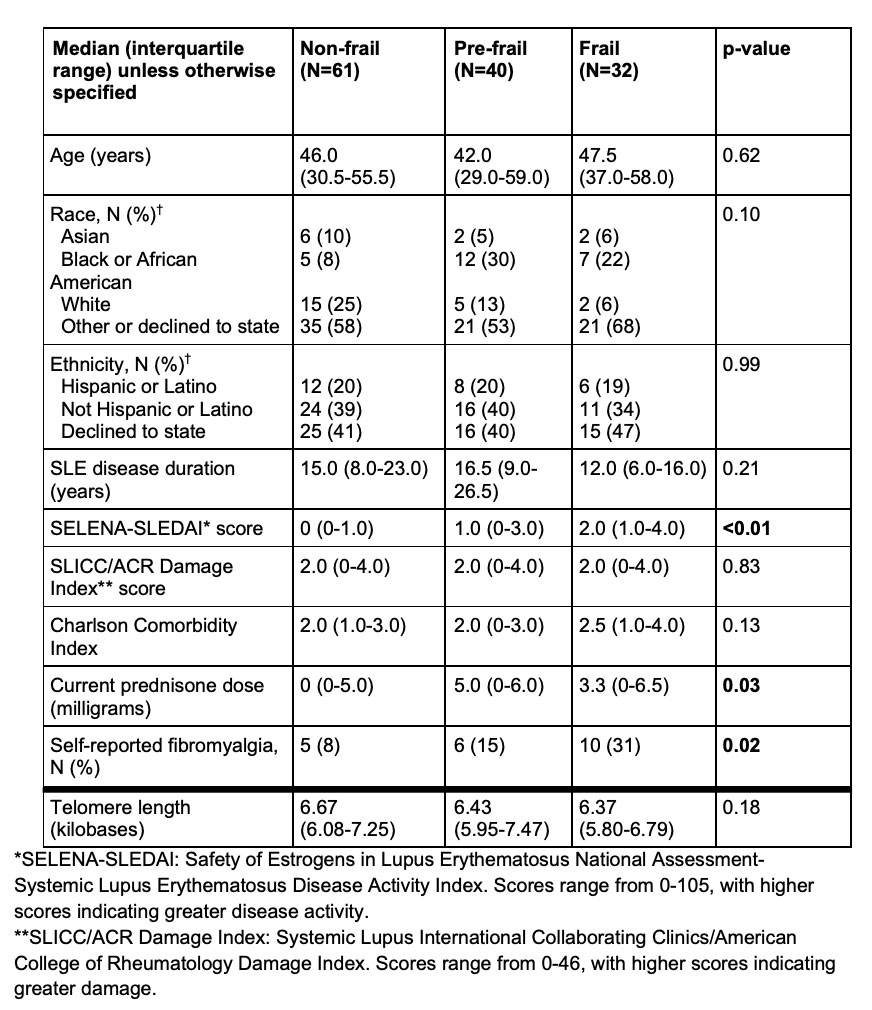Session Information
Date: Monday, November 14, 2022
Title: SLE – Diagnosis, Manifestations, and Outcomes Poster III: Outcomes
Session Type: Poster Session D
Session Time: 1:00PM-3:00PM
Background/Purpose: Frailty is an increasingly recognized risk factor for adverse health outcomes in systemic lupus erythematosus (SLE). Preliminary evidence is conflicting regarding whether telomere length, a marker of cellular senescence, is associated with frailty in SLE [1-2]. We aimed to evaluate differences in telomere length among frail, pre-frail, and non-frail women with SLE according to the Fried phenotypic frailty definition and to assess whether telomere length is independently associated with frailty after adjusting for multiple potential confounders.
Methods: Women ≥18 years old with SLE validated according to the 2019 European League Against Rheumatism/American College of Rheumatology Classification Criteria were enrolled at a single center. Frailty status was determined during a study visit according to the Fried phenotypic definition, which includes 5 objective and self-report criteria; frailty and pre-frailty are present when ≥3 and 1-2 criteria are met, respectively. Telomere length was determined from whole blood drawn at the same visit using Southern analysis of terminal restriction fragments. Sociodemographic features and clinical characteristics also were collected at the same visit. Differences among frail, pre-frail, and non-frail participants were evaluated using Fisher’s exact or Wilcoxon rank sum tests. The association of telomere length with frailty was assessed using ordinal regression following multiple imputation analysis for missing data.
Results: 32/133 (24.1%) and 40/133 (30.1%) participants were classified as frail and pre-frail, respectively. Disease activity (p< 0.01), fibromyalgia (p=0.02), and disability (p< 0.01) differed among frail, pre-frail, and non-frail individuals in a dose-dependent fashion. Telomere length was shorter in frail as compared to pre-frail and non-frail individuals, but this did not reach statistical significance. A non-statistically significant trend toward an association of shorter telomere length with frailty was present.
Conclusion: Although a trend in the relationship was detected, shorter telomere length was not significantly associated with Fried phenotypic frailty in this single center cross-sectional sample. Further study is needed in larger longitudinal cohorts to clarify the relationship between telomere length and Fried phenotypic frailty status.
References :
1. Lima K et al. Arthritis Rheumatol 2020;72(suppl 10).
2. Lieber S. et al. Arthritis Rheumatol 2021;73(suppl 10).
To cite this abstract in AMA style:
Lieber S, Lipschultz R, Zahid S, Lin M, Lue N, Mandl L. Association of Telomere Length with Phenotypic Frailty in Adults with Systemic Lupus Erythematosus [abstract]. Arthritis Rheumatol. 2022; 74 (suppl 9). https://acrabstracts.org/abstract/association-of-telomere-length-with-phenotypic-frailty-in-adults-with-systemic-lupus-erythematosus/. Accessed .« Back to ACR Convergence 2022
ACR Meeting Abstracts - https://acrabstracts.org/abstract/association-of-telomere-length-with-phenotypic-frailty-in-adults-with-systemic-lupus-erythematosus/


